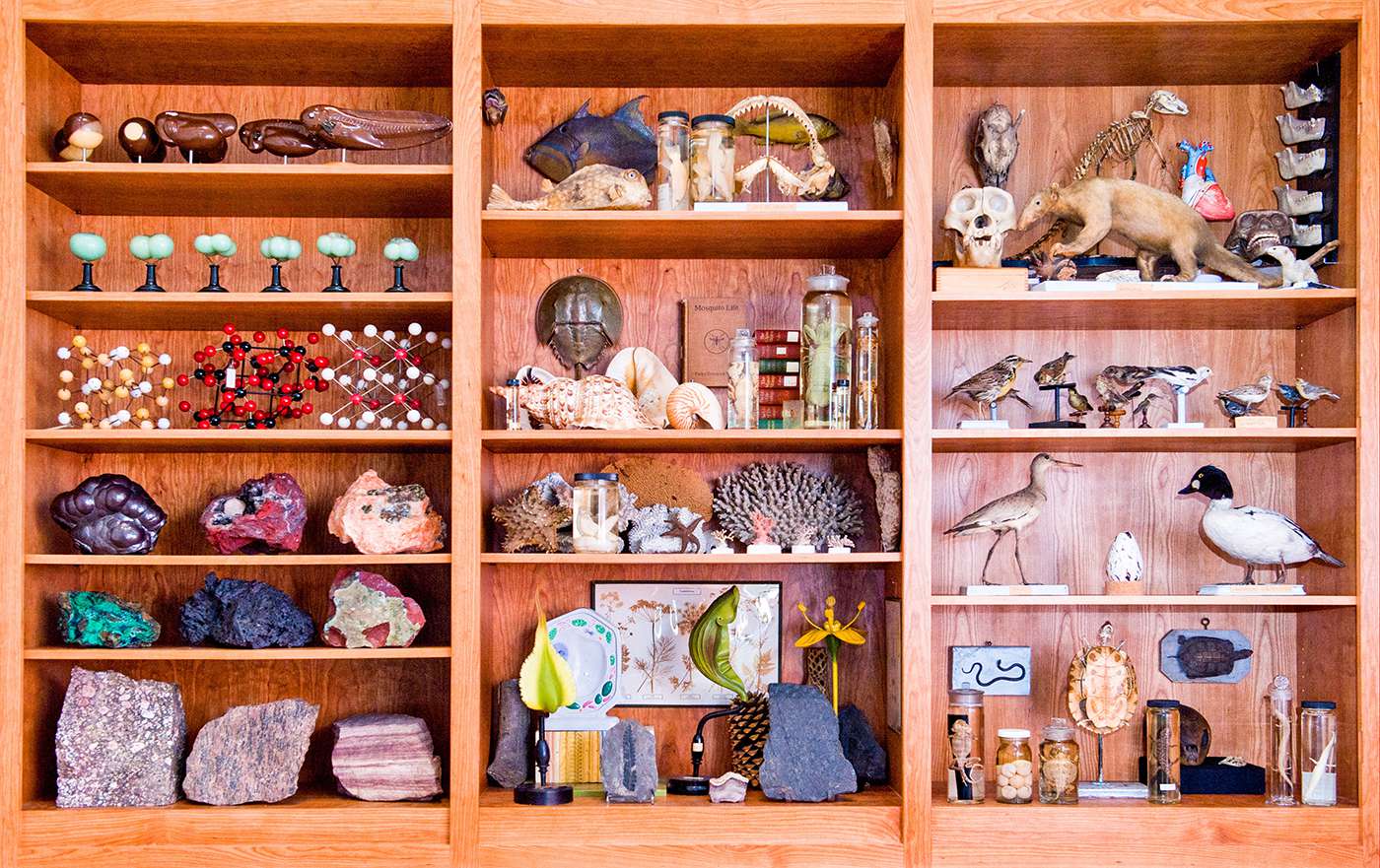A stuffed loon, an invitation to the 1879 Vassar Commencement, some carved African masks, a wallaby skeleton, and a softball trophy. These items, and many more eclectic pieces from the college’s past and present, are what you get when you bring renowned visual artist Mark Dion to the college and have him lead an American and Environmental Studies class on a campus-wide treasure hunt.
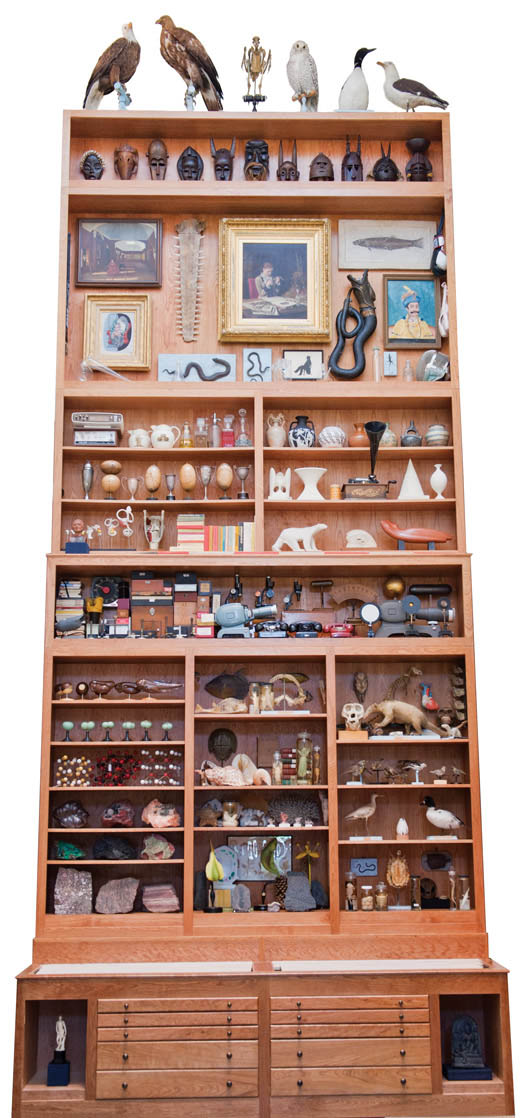
The result of this semester-long quest is Dion’s latest work, “Universal Collection: A Mark Dion Project,” now on display in the atrium of the Frances Lehman Loeb Art Center. A 23-foot-high custom-made cabinet is filled with objects Dion gathered with the help of students in a Creative Arts Across Disciplines (CAAD)-supported course taught by Professor of Anthropology Anne Pike-Tay called “From the Natural History Museum to Ecotourism: The Collection of Nature.” The cabinet, which temporarily supplants a large portrait of Matthew Vassar, will remain on display through the end of the fall semester.
Dion, whose creations have been shown in such venues as the Museum of Modern Art in New York City, the Tate Gallery in London, and the Olympic Sculpture Park in Seattle, says, “My goal is to tell a story in a way that is a little jarring. This isn’t a straight-line history of Vassar, but it’s not a mad, random treasure hunt either. There’s a structure and methodology behind it.”
Pike-Tay calls the project “an exercise in making critical choices across the spectrum of Vassar’s history.” She says her course illustrates how museums and parks and other public spaces are products of those who make the decisions about how they’re created. Dion’s cabinet, she notes, is not an objective representation of Vassar. “We all bring our own assumptions and preferences as we select these objects,” Pike-Tay says, “and we are bound by what is actually still here.”
Mary-Kay Lombino, the Emily Hargroves Fisher ’57 and Richard B. Fisher Curator of the Frances Lehman Loeb Art Center, had been familiar with Dion’s work for more than 15 years. She decided to reach out to him in 2014 to ask him if he’d be interested in doing something at Vassar. “We discussed it over lunch, and Mark visited the campus for the first time about a year ago,” Lombino says. “He was immediately impressed with the amount of material Vassar had and with the collaboration of the faculty and staff in preserving it.
“The beauty of the project was that he came here with no preconceived ideas and allowed the objects themselves to be his guide,” Lombino continues. “It was all an experiment—we’d never done anything like this before—but I’m amazed by what we’ve gathered for this exhibit, the sheer volume and the surprising diversity of objects.”
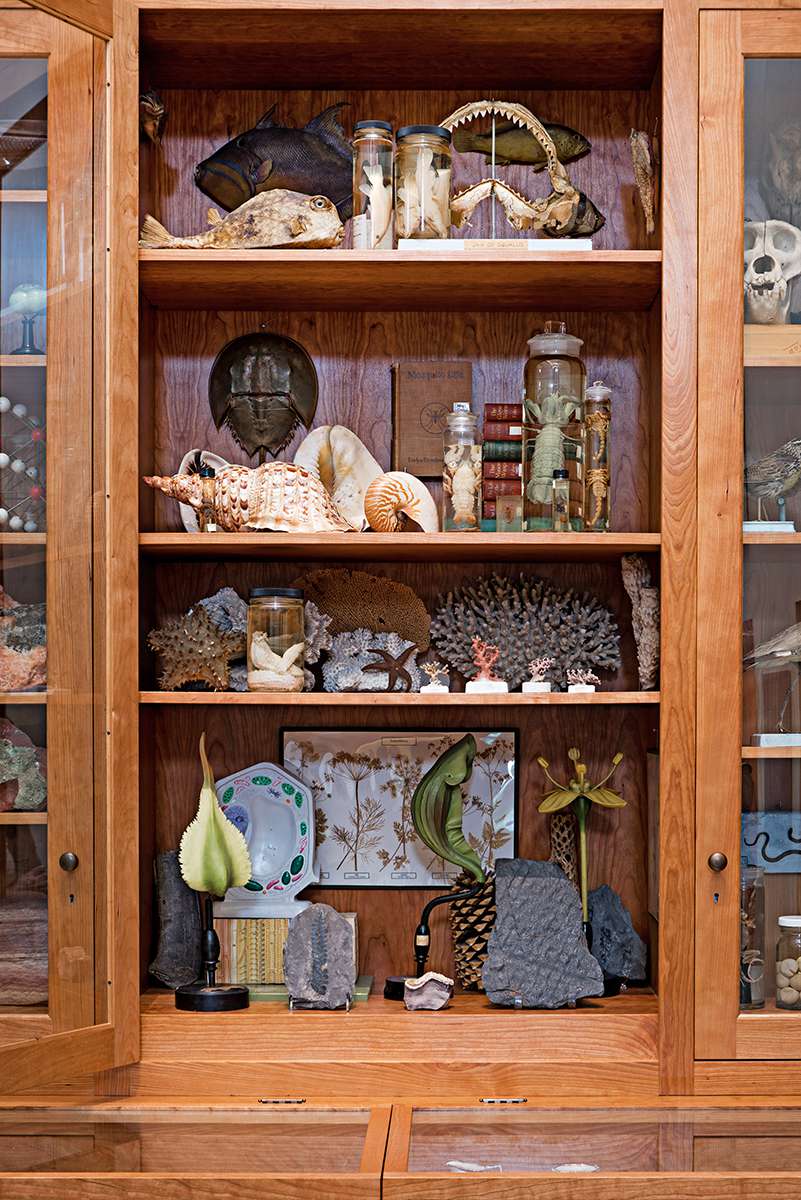
Dion, who has created such cabinets at other colleges, says the Vassar project was one of his favorites because he had so much material from which to choose. “Vassar has done a better job than most institutions in preserving pieces of its history,” he says. “The college has a strong culture and strong traditions that I wanted to make sure the cabinet reflects.”
The students spent several class periods scouring the campus for candidates for the cabinet. They started their search in Pike-Tay’s office in Blodgett Hall, where they found the skeleton of the wallaby, then went on to scour the Art Center and the Library’s Archives and Special Collections. They also spent a few hours viewing old teaching tools and artifacts belonging to the Vassar College Artifacts Project (VCAP)—its objects also are showcased in the recently renovated Olmsted, New England, and Sanders Physics buildings and in the new Bridge for Laboratory Sciences. (See the Winter 2016 issue of VQ for a story on VCAP.)
Some searches were more fruitful than others. Dion and the students spent more than an hour prowling through the dusty basement of Main without turning up much of interest. “The trip down there was only minimally successful,” Dion says, “but you never know what you’ll find if you don’t look.”
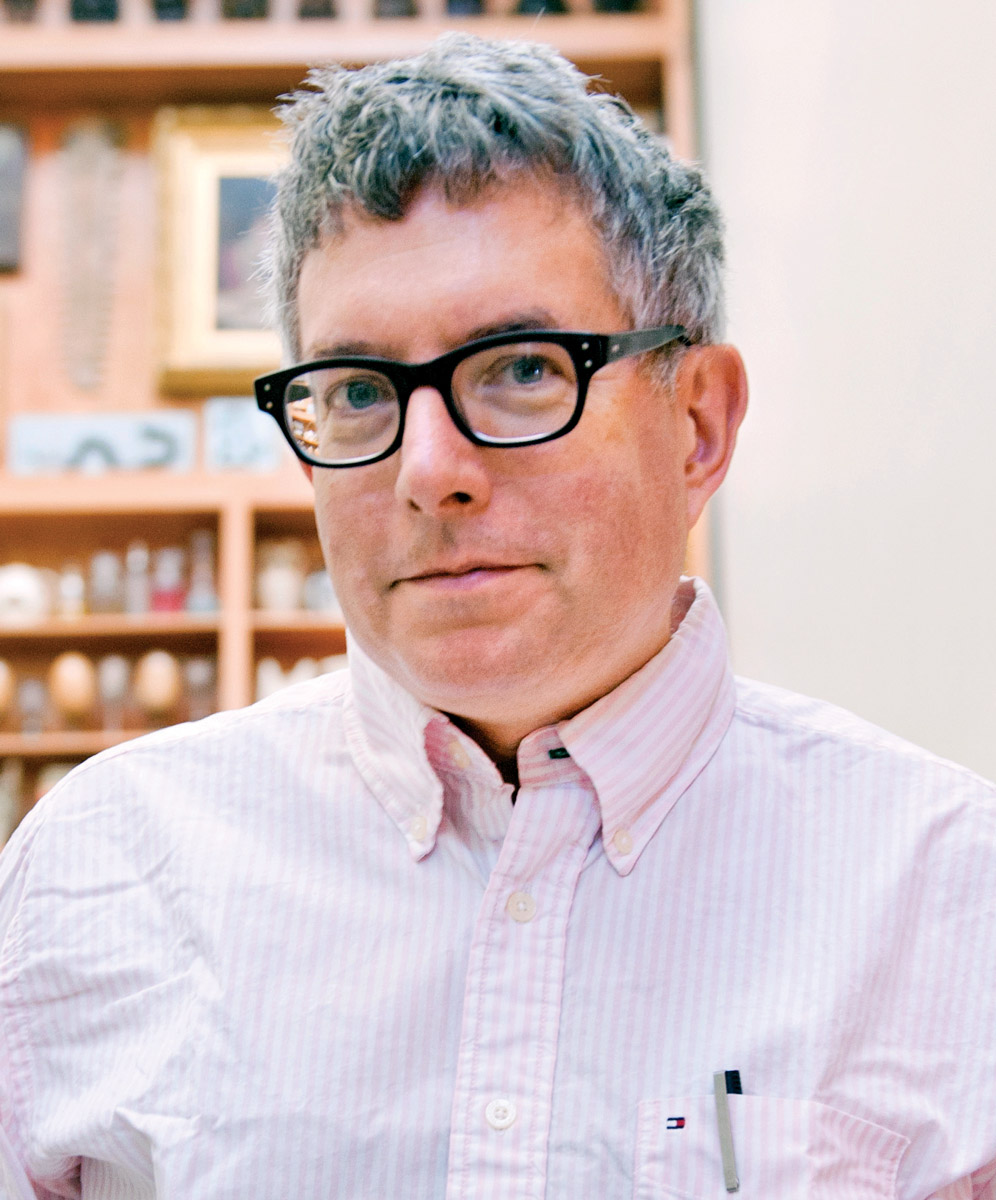
Dion says Vassar’s appreciation of its own history and the sheer volume of interesting material it has amassed over the past 155 years contributed to the ultimate success of the treasure hunt. “I had a lot of advantages with this project because Vassar has an amazing art collection that is thoroughly catalogued, a natural history museum, the VCAP items, and a significant amount of material of value and quality in the Special Collections section in the library,” he says.
The students say they enjoyed collaborating with the artist on the project. “I’ve taken some art courses that touch on collecting, how works of art are chosen by museums,” says Sophie Koreto ’18, an art history and French double major from Suffern, NY. “This course taught me that collections are often not the most beautiful objects but the ones that are instructive, the ones that show how people lived,” Koreto says.
Lydia Wood ’17, a religion major from Philadelphia, says she and her classmates were captivated by Dion’s energy and enthusiasm. “The way Mark explained how he wanted to create the installation changed the way I think about the exhibition of material,” Wood says. “My long-term goal is to have a career in museum curating, and this course was really helpful.”
Some of the students in Pike-Tay’s course visited the museum after classes had ended to watch Dion place the objects in the cabinet. Liliana Sabsowitz Silverman ’16, an environmental studies major from Philadelphia, who had chosen some rocks and minerals from the Earth Sciences Department for the cabinet, said of the finished piece: “It’s beautiful; it’s incredible. It’s nice to see all the stuff we worked so hard to find.”
“Universal Collection” will continue to be used as an educational tool when classes resume in the fall. Elizabeth Nogrady ’99, the museum’s curator of academic programs, says faculty members from various disciplines plan to integrate it into their curricula. She says she’s confident that those familiar with Vassar and its history, and even those who are not, will enjoy the encounter with the towering collection of Vassar’s stuff. “One of the fulfilling things for people visiting a museum is the spark of recognition they get when they see something familiar in a work,” Nogrady says, “and this piece offers hundreds of opportunities for that to happen.”
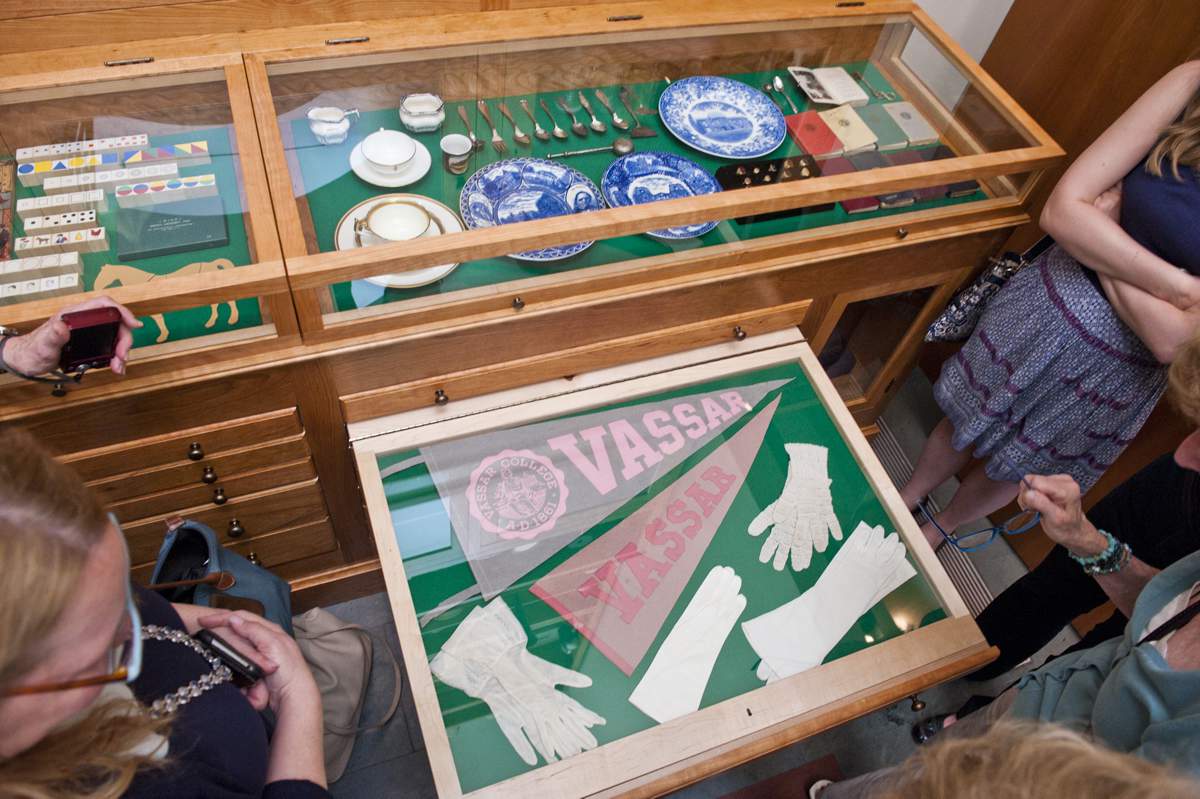
As he surveyed his finished product, Dion said he had adorned most of the drawers and shelves with objects just as he had planned, but some of the assembly process was a bit more spontaneous. “Sometimes, it’s a matter of spacing,” he says. “I’m a ‘more is more’ kind of guy, but you have to avoid overwhelming people, so you have to move from order to chaos and back to order again.”
While he was happy with what he had created and was particularly pleased to secure two pitchers from Matthew Vassar’s brewery, Dion said he did have one regret: “I wish I had a Vassar Brewery beer bottle.”
